Introduction to Vegetable Soup
When you think of what makes the ultimate homemade meal, vegetable soup often tops the list. It's comforting, nutritious, and incredibly versatile, allowing you to tailor it to your taste preferences or what you have in your pantry. This delightful dish brings together a variety of fresh vegetables, creating a heartwarming bowl that can be savored any time of the year.
So, why is vegetable soup such a beloved choice? For starters, it's an excellent way to sneak in those essential vitamins and minerals, especially for busy young professionals looking to maintain a balanced diet. According to the Centers for Disease Control and Prevention (CDC), increasing your vegetable intake can significantly improve your overall health.
Another appealing aspect of vegetable soup is its adaptability. You can use seasonal produce, leftovers, or whatever you fancy. Have some spinach wilting in the fridge or a zucchini looking for a home? Toss it in! This flexibility doesn't just simplify meal prep but also fosters creativity in the kitchen.
Ready to dive into a delightful recipe that’s quick and satisfying? Let’s get cooking!
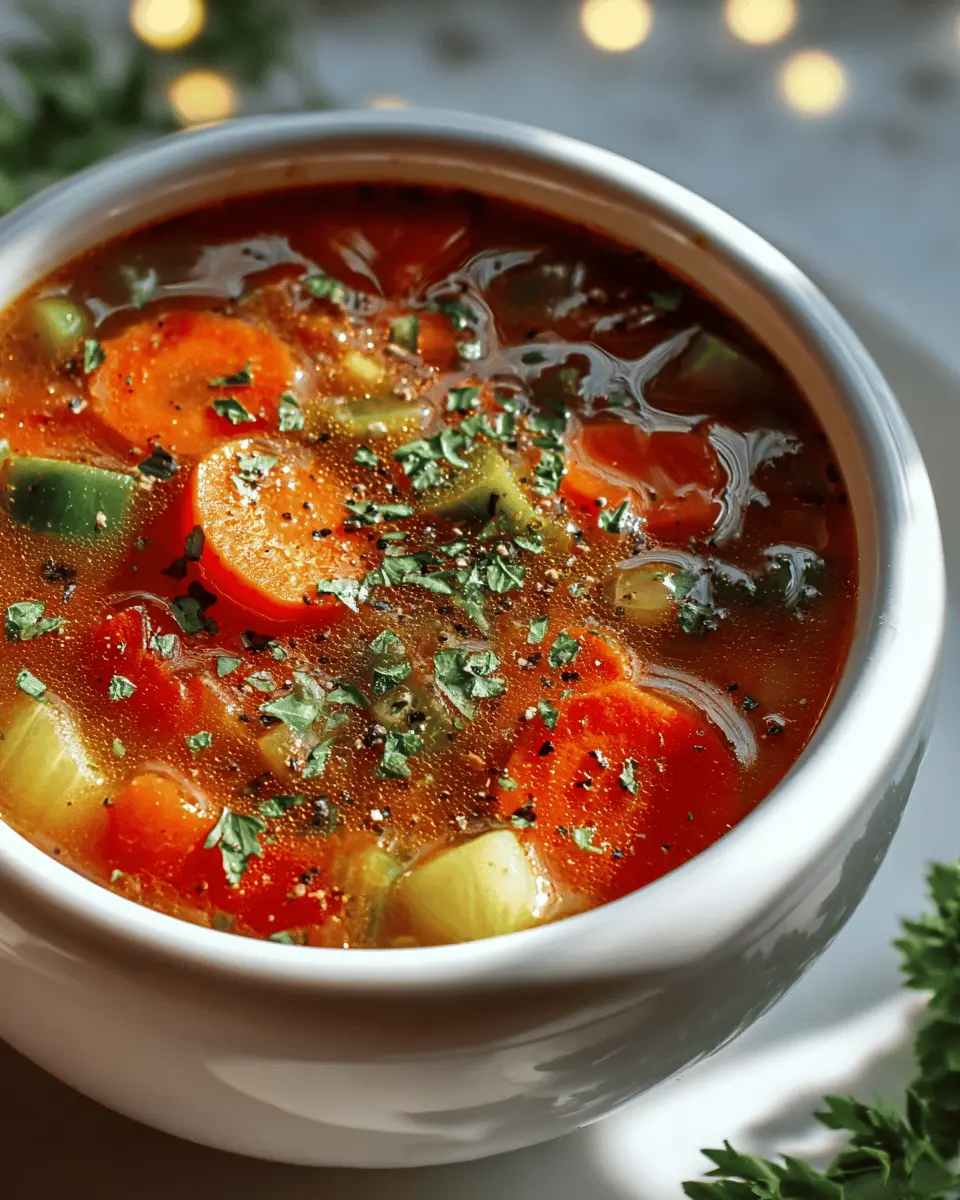
Ingredients for Vegetable Soup
When it comes to making a hearty bowl of vegetable soup, having the right ingredients is essential. This recipe is not only simple but also customizable, allowing you to add your personal touch. Here’s what you’ll need:
- 1 tablespoon olive oil: For that rich, savory base.
- 1 onion, chopped: Adds a sweet flavor when sautéed and a wonderful aroma.
- 2 carrots, sliced: Offers texture and a hint of sweetness.
- 2 stalks celery, sliced: Brings a subtle earthiness that enhances the overall flavor.
- 2 cloves garlic, minced: Because garlic makes everything better—right?
- 4 cups vegetable broth: This is the heart of your soup, providing depth and richness.
- 1 zucchini, chopped: Adds nice color and nutrition; don't skip this!
- 1 cup peas: For a pop of sweetness and vibrant green color.
- 1 can (15 oz) diced tomatoes: Adds acidity and makes the soup truly comforting.
- 1 teaspoon dried thyme: A perfect herb that complements the vegetable medley.
- Salt and pepper to taste: Essential for balancing flavors.
For best practices on choosing fresh vegetables, check out this expert guide from the Produce Marketing Association! With these ingredients, you're well on your way to crafting a delightful bowl of vegetable soup. Now, let’s get cooking!
Preparing Vegetable Soup
Making a hearty vegetable soup is not just a way to nourish your body; it can also be a delightful experience for your senses. Nothing beats the smell of fresh vegetables gently simmering on the stove. Let’s break down the steps to prepare this comforting dish that’s perfect for any occasion.
Gather your ingredients
Before you dive in, it’s essential to get organized. A well-stacked kitchen will make your cooking experience much smoother. Here’s what you’ll need for your delightful vegetable soup:
- 1 tablespoon olive oil
- 1 onion, chopped
- 2 carrots, sliced
- 2 stalks celery, sliced
- 2 cloves garlic, minced
- 4 cups vegetable broth
- 1 zucchini, chopped
- 1 cup peas
- 1 can (15 oz) diced tomatoes
- 1 teaspoon dried thyme
- Salt and pepper to taste
Having all your ingredients ready means you can focus on crafting a delicious meal. It’s okay to improvise based on personal preferences; feel free to add other vegetables like kale or bell peppers if you have them on hand!
Sauté vegetables for best flavor
Heat that olive oil in a pot over medium heat. You want to see a gentle shimmer in the oil, signaling it’s ready. New cooks often rush this step, but trust me—sautéing your vegetables will unlock a world of flavor. Start with the onion, carrots, and celery, letting them soften for about 5-7 minutes. This creates a delicious base for your vegetable soup. Add the garlic in the last minute; burning garlic can turn it bitter, and we definitely want to avoid that!
Add broth and simmer
Once your veggies are looking beautiful and fragrant, it’s time to stir in the broth. Pour in those 4 cups of vegetable broth along with the zucchini, peas, and diced tomatoes. This combination is a flavor fiesta waiting to happen! Bring the mixture to a boil, then reduce the heat and let it simmer for about 20-25 minutes.
This period is crucial for the flavors to meld. According to The Kitchn, simmering allows for a wonderful depth of flavor.
Incorporate your herbs and spices
Don’t forget to season! Once your vegetable soup has simmered, it’s time to add your herby touch. Sprinkle in the dried thyme, a generous pinch of salt, and freshly cracked black pepper to taste. Taste as you go; this is your masterpiece, after all! The right spices can make all the difference.
Enjoy the aroma while it cooks
As your soup simmers, take a moment to enjoy the enticing aroma wafting through your kitchen. It’s not just a smell; it’s the anticipation of a healthy meal that’s about to nourish you. Use this time to clean up your cooking area or maybe even pour yourself a warm drink. The joy of cooking is as much about the experience as it is about the food itself.
Now, you're all set! Your vegetable soup is just about ready to be served. Enjoy it with some crusty bread for a complete meal!
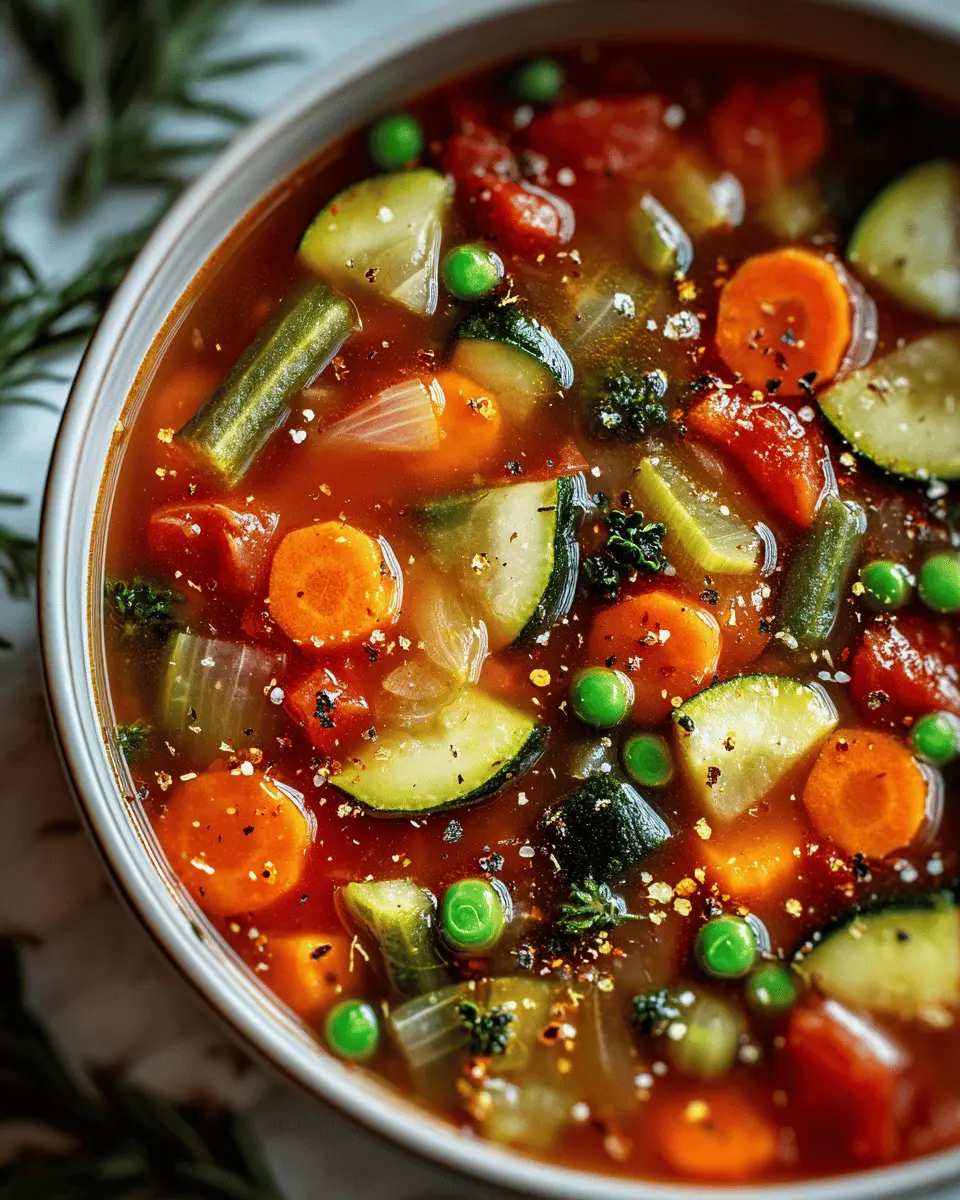
Variations on Vegetable Soup
Hearty Vegetable and Turkey Bacon Soup
For a heartier spin on your vegetable soup, try adding crunchy turkey bacon. Simply sauté chopped turkey bacon in the pot before adding your veggies. This gives your soup an irresistible smoky flavor that perfectly complements the fresh ingredients. Plus, turkey bacon is a leaner alternative to traditional pork bacon, making it a healthier option. Give it a try and explore more about plant-based substitutions on sites like Healthline.
Spicy Vegetable Soup with Added Kick
If you're looking to spice things up, consider adding a kick to your vegetable soup with jalapeños or red pepper flakes. Start by sautéing chopped jalapeños along with your onions for an extra layer of flavor. For a more substantial kick, mix in a teaspoon of chili powder or hot sauce before simmering. Not only does this add warmth, but it can also enhance your metabolism, making it a perfect fit for your busy lifestyle! Discover more health benefits of spicy foods at WebMD.
Cooking Tips and Notes for Vegetable Soup
Fresh vs. Frozen Vegetables
When making vegetable soup, both fresh and frozen veggies have their benefits. Fresh vegetables often provide the best flavor and texture, especially when in season. However, frozen vegetables can be just as nutritious because they’re often frozen at peak ripeness. If you're short on time, opt for frozen—just be sure to check for any added preservatives.
Importance of Tasting and Adjusting Flavors
One of the joys of cooking is tailoring flavors to your preference. While the soup cooks, don’t hesitate to taste and adjust. Add more salt, pepper, or even a splash of lemon juice for brightness. Your unique palate is the best guide! For more on balancing flavors, check out this guide from The Kitchn.
Remember, kitchen experimentation is part of the fun!
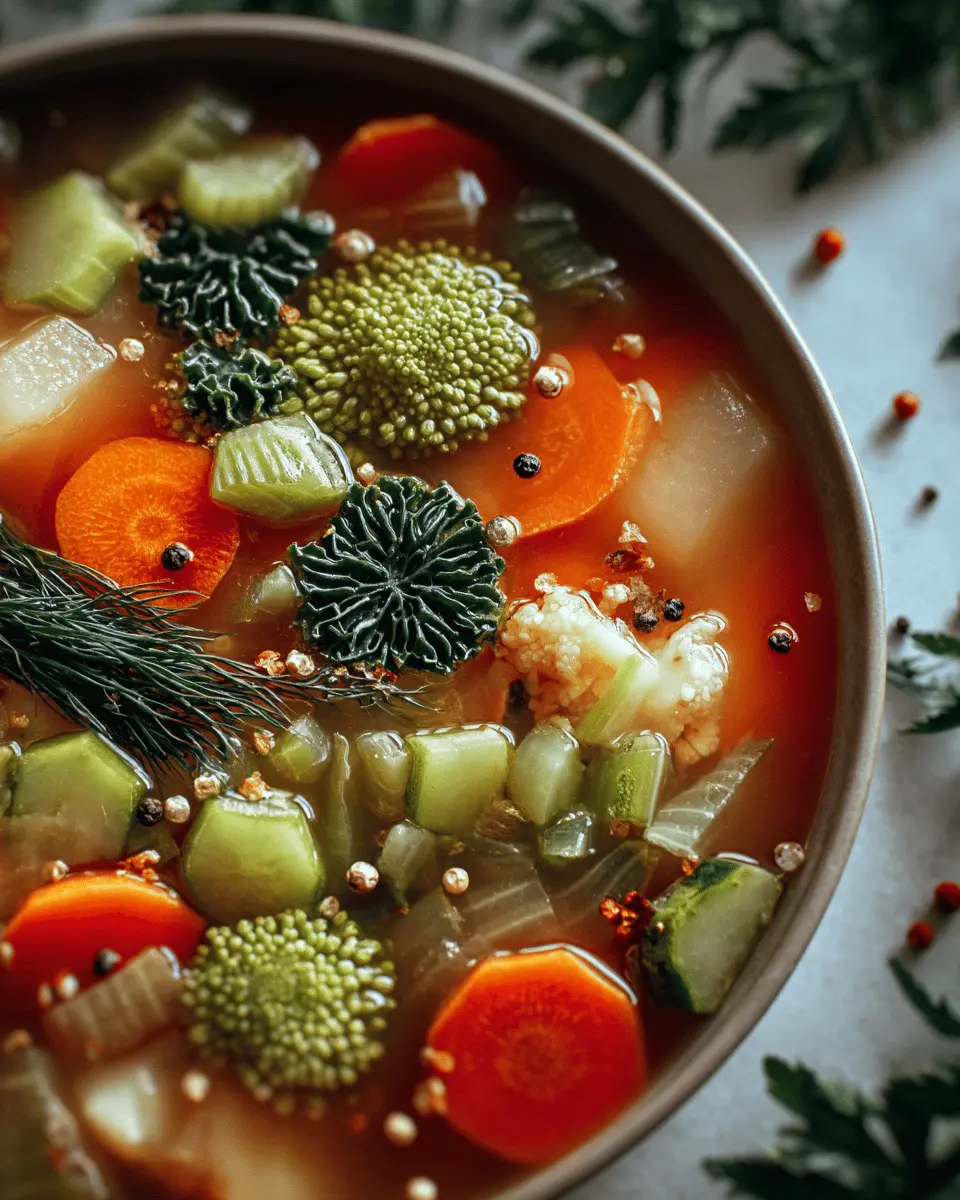
Serving suggestions for Vegetable Soup
Pairing options with bread or crackers
To elevate your vegetable soup experience, consider pairing it with warm, crusty bread or crispy crackers. A slice of sourdough or whole-grain bread absorbs flavors beautifully and adds a satisfying texture. If you're in a rush, serving it alongside toasted pita chips or buttery water crackers can be a delightful crunch that complements the soup's warmth. You might even try homemade garlic bread for that extra zing!
Creative garnishes to enhance presentation
Presentation matters, even with a comforting bowl of vegetable soup. A sprinkle of fresh herbs like parsley or basil adds a vibrant touch. For a creamy finish, drizzle a bit of olive oil or a dollop of Greek yogurt on top. You could also toss in a few croutons for a fun texture and visual appeal. These simple enhancements not only look great but also surprise your palate with each delectable spoonful! If you're curious about more ways to garnish, check out these creative tips.
Time Breakdown for Vegetable Soup
Preparation Time
Getting your ingredients ready for vegetable soup should take about 10-15 minutes. This is when you’ll chop your veggies and measure out your soup components. It’s a great time to listen to your favorite podcast or catch up on a show!
Cooking Time
The actual cooking process is fairly quick, generally around 25-30 minutes in total. Sauté the vegetables, let the flavors meld, and before you know it, you’ll have a pot full of warm, comforting goodness!
Total Time
Overall, you’re looking at approximately 40-45 minutes from start to finish. Perfect for a weeknight dinner when time is of the essence but you still want something healthy and delicious.
For tips on chopping techniques, check out this helpful guide that’ll cut your prep time in half. If you're interested in how to store vegetable soup leftovers properly, this resource has all the info you need!
Nutritional Facts for Vegetable Soup
Understanding the nutritional benefits of your meals is key to a healthy lifestyle. Here’s a quick breakdown of the nutritional facts for vegetable soup:
Calories
A serving of vegetable soup typically contains around 70-120 calories, making it a fantastic low-calorie option! It’s perfect for those looking to enjoy a filling dish without the calorie overload.
Protein
While vegetable soup isn’t a significant source of protein, it provides about 3-5 grams per serving. To boost the protein content, consider adding beans or lentils, which pair well with the flavors of the soup.
Fiber
One of the standout features of vegetable soup is its fiber content, averaging 4-6 grams per serving. High fiber meals are essential for digestion and keeping you feeling full, which is why this soup can help curb those pesky snack cravings.
For more on fiber-rich foods, check out Healthline.
Incorporating vegetable soup into your weekly meal prep can be a delicious way to increase your intake of essential nutrients. Plus, it’s super easy to customize with your favorite veggies!
FAQs about Vegetable Soup
Can I use any vegetable for vegetable soup?
Absolutely! One of the best things about vegetable soup is its versatility. You can mix and match whatever vegetables you have on hand. Think leafy greens, bell peppers, or even root vegetables like turnips and parsnips. Just be mindful of cooking times—harder veggies take longer to soften than tender ones.
How do I store leftover vegetable soup?
Store your leftover vegetable soup in an airtight container in the fridge for up to 3-4 days. If you're looking to keep it longer, consider freezing portions in freezer-safe bags or containers. Just thaw in the fridge overnight before reheating for your next cozy meal.
How can I make it more filling?
To make your vegetable soup more substantial, try adding proteins such as lentils, beans, or shredded Turkey Bacon. You can also stir in whole grains like quinoa or barley for added texture and nutrition. These ingredients not only amp up the heartiness but also enhance the flavor profile of your soup!
For more soup inspiration, check out this popular recipe site or Nutritional Guidelines for tips on incorporating various ingredients.
Conclusion on Vegetable Soup
In summary, making a vegetable soup is not just a comforting way to nourish your body; it's also an opportunity to unleash your creativity in the kitchen. This versatile dish can be tailored to your taste preferences and dietary needs. Whether you're enjoying it solo or sharing with loved ones, a warm bowl of vegetable soup brings joy to any meal. So why not whip up a batch today and savor the goodness? For more delicious recipes and tips on healthy eating, check out sources like EatingWell or Nutrition.gov. Enjoy!
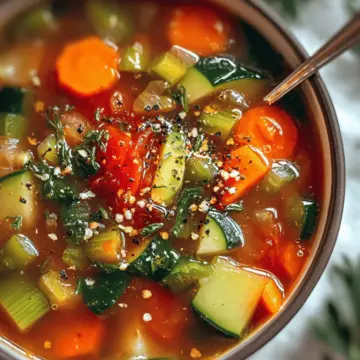
Vegetable Soup Bliss: Easy, Healthy Recipe for Cozy Nights
Equipment
- Pot
Ingredients
- 1 tablespoon olive oil
- 1 onion chopped
- 2 carrots sliced
- 2 stalks celery sliced
- 2 cloves garlic minced
- 4 cups vegetable broth
- 1 zucchini chopped
- 1 cup peas
- 1 can diced tomatoes (15 oz)
- 1 teaspoon dried thyme
- Salt to taste
- pepper to taste
Instructions
- Heat olive oil in a pot over medium heat. Add onion, carrots, and celery; sauté until softened.
- Stir in garlic, broth, zucchini, peas, tomatoes, thyme, salt, and pepper. Bring to a boil.
- Reduce heat and simmer for 20-25 minutes.


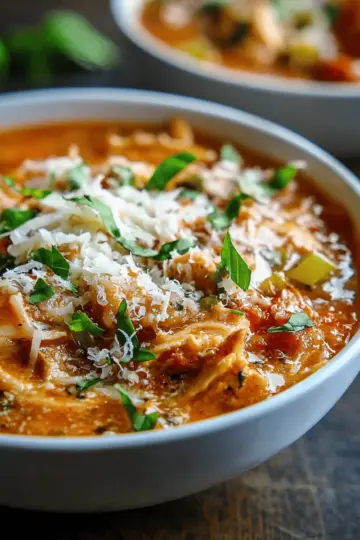

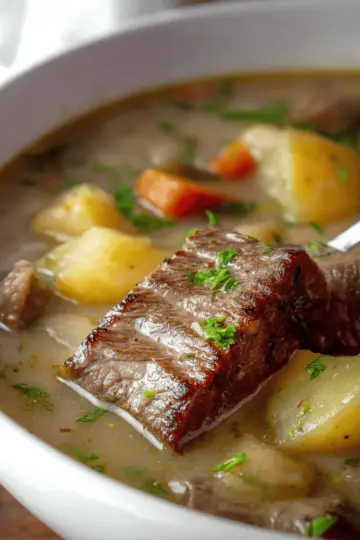
Leave a Reply